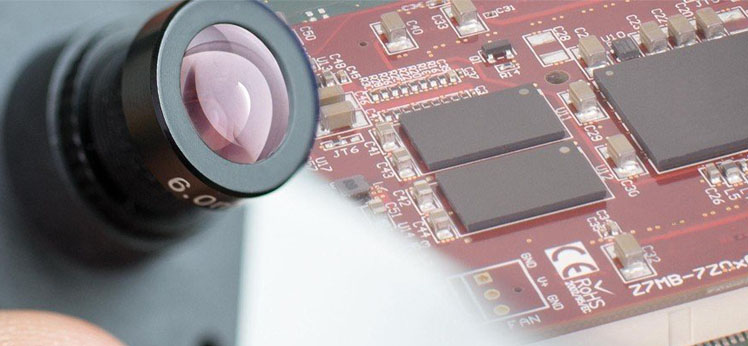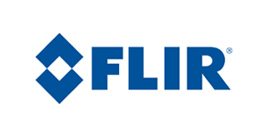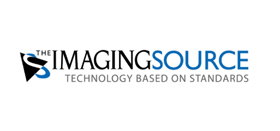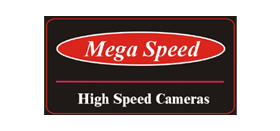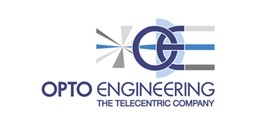In recent years, a miniaturization trend has been established in many areas of electronics. For example, ICs have become more and more integrated and circuit boards in the electrical industry have become smaller and more powerful. This has also made PCs, mobile phones and cameras more and more compact and also more powerful. This trend can also be observed in the world of vision technology.
A classic machine vision system consists of an industrial camera and a PC:
Both were significantly larger a few years ago. But within a short time, smaller and smaller-sized PCs became possible, and in the meantime, the industry saw the introduction of single-board computers (SPCs), i.e. computers that can be found on a single board. At the same time, the camera electronics became more compact and the cameras successively smaller. On the way to even higher integration, small cameras without housings are now offered, which can be easily integrated into compact systems.
Due to these two developments, the reduction in size of the PC and the camera, it is now possible to design highly compact camera vision systems for new applications. These systems are called embedded (vision) systems.
Design and use of an embedded vision system
An embedded vision system consists, for example, of a camera, so-called board level camera, which is connected to a processing board. Processing boards take over the tasks of the PC from the classic machine vision setup. As processing boards are much cheaper than classic industrial PCs, vision systems can become smaller and also more cost-effective. The interfaces for embedded vision systems are primarily USB, Basler’s BCON for MIPI or BCON for LVDS.
Embedded vision systems are used in a wide range of applications and devices, such as in medical technology, in vehicles, in industry and in consumer electronics. Embedded systems enable new products to be created and thereby create innovative possibilities in several areas.
Which Embedded Systems Are Available?
A so-called SoC (system on chip) lies at the heart of all embedded processing solutions. This is a single chip on which the CPU (which may be multiple units), graphics processors, controllers, other special processors (DSP, ISP) and other components are integrated.
Due to these efficient SoC components, embedded vision systems have become available in such a small size and at a low cost only recently.
As embedded systems, there are popular single-board computers (SBC), such as the Raspberry Pi® or DragonBoard®. These are mini-computers with the established interfaces (USB, Ethernet, HDMI, etc.) and a range of features similar to traditional PCs or laptops, although the CPUs are of course less powerful.
Embedded vision solutions can also be designed with a so-called SoM (system on module, also called computer on module or CoM). In principle, an SoM is a circuit board which contains the core elements of an embedded processing platform, such as the SoC, storage, power management, etc. An individual carrier board is required for the customization of the SoM to each application (e.g. with the appropriate interfaces). This is connected to the SoM via specific connectors and can be designed and manufactured relatively simply. The SoMs (or the entire system) are cost-effective on the one hand since they are available off-the-shelf, while on the other hand they can also be individually customized through the carrier board.
Completely individual processing boards in the form of a full custom design may also be a sensible choice for high quantities.
Characteristics of Embedded Vision Systems versus Standard Vision Systems
Most of the above-mentioned single board computers and SoMs do not include the x86 family processors common in standard PCs. Rather, the CPUs are often based on the ARM architecture.
The open-source Linux operating system is widely used as an operating system in the world of ARM processors. For Linux, there is a large number of open-source application programs, as well as numerous freely-available program libraries. Increasingly, however, x86-based single-board computers are also spreading. A consistently important criterion for the computer is the space available for the embedded system.
For the software developer, the program development for an embedded system is much more complex than for a standard PC. While the PC used in standard software development is also the main target platform (meaning the type of computer which the program is later intended to run on), this is different in the case of embedded software, where the target system generally can’t be used for the development due to its limited resources (CPU performance, storage). This is why the development of embedded software also uses a standard PC on which the program is coded and compiled with tools that may get very complex. The compiled program must then be copied to the embedded system and subsequently be debugged remotely.
When developing the software, it should be noted that the hardware concept of the embedded system is oriented to a specific application and thus differs significantly from the universally usable PC.
However, the boundary between embedded and desktop computer systems is sometimes difficult to define. Just think of the popular Raspberry Pi, which on the one hand has many features of an embedded system (ARM-based, single-board construction), but on the other hand can cope with very different tasks and, with the connection of a monitor, mouse and keyboard, is therefore a universal computer.
What Are the Benefits of Embedded Vision Systems?
In some cases, much depends on how the embedded vision system is designed. An SBC (single-board computer) is often a good choice, as this is a standard product. It is a small compact computer that is easy to use. This solution is also useful for developers who have had little to do with embedded vision.
On the other hand, however, the single-board computer is a system which contains unused components and thus generally does not allow the leanest system configuration. For that reason, this approach is not very economical in terms of manufacturing costs and is more suitable for small unit numbers, where the development costs must be kept low while the manufacturing costs are of secondary importance.
The leanest setup is obtained with a full-custom design, a system that is highly optimized for individual applications. But this involves high integration costs and the associated high development expenditures. This solution is therefore suitable for large unit numbers.
An approach with a conventionally available system on module (SoM) and an appropriately customized carrier board presents a compromise between an SBC and a full-custom design (also see above: “Which embedded systems are available? “). The manufacturing costs are not as optimized as in a full custom design (after all, a setup with a carrier board plus a more or less generic SoM is a bit more complex), but at least the hardware development costs are lower, since the significant part of the hardware development is already completed with the SoM. This is why a module-based approach is a very good choice for medium-level unit numbers in which the manufacturing and development costs must be well-balanced.
The benefits of embedded vision systems at a glance:
- Leaner system design
- Light weight
- Cost-effective, because there is no unnecessary hardware
- Lower manufacturing costs
- Low energy consumption
- Small footprint
Also Read: HOW HIGH-SPEED CAMERAS CAN BE USED TO STUDY HUMAN MOTION SEQUENCES
Back to All Robotics and Autonomous Systems Articles, Resources and News
Share This:
To Know More About Machine Vision Cameras Dealer in Singapore Asia , Contact MVAsia Infomatrix Pte Ltd at +65 6329-6431 or Email us at info@mvasiaonline.com
Source - www.baslerweb.com


